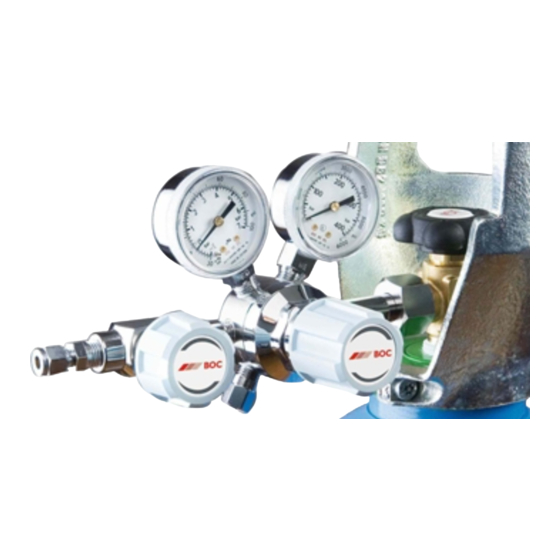BOC BASELINE C106X/1 Manual do utilizador - Página 5
Procurar online ou descarregar pdf Manual do utilizador para Controlador BOC BASELINE C106X/1. BOC BASELINE C106X/1 8 páginas. Cylinder and secondary pressure regulators

5. Marking.
The nameplate lists the model number, Inlet fitting number and serial
number of the pressure equipment as well as the manufacturers name.
Caution
Only use equipment that corresponds with the type of gas and operating pressures for which it was intended. The maximum
intended inlet pressure is listed on the pressure equipment. Failure to observe the intended use can result in the danger of
injury, the danger to life, the danger of equipment failure, or fittings being damaged.
6. Connection.
Cylinder regulators
Danger
Thread on cylinder valve and swivel nut must
not show signs of damage, dirt, grease, oil,
foreign matter or metal shavings.
Warning
Only use new gaskets. Gaskets must not be
deformed, nor show traces of dirt or metal
shavings.
Warning
Do not overly tighten the mounting fitting, as
the thread and the gasket could be damaged.
This can result in leakage, uncontrolled release
of gas, or loss of the entire cylinder or gas sup-
ply contents.
Caution
Before connecting, check whether the equip-
ment to be used is suitable for the planned
application (type of gas, pressure, etc.)
BASELINE
cylinder and secondary pressure regulators
®
Preparation
Only use regulators with cylinder connections that correspond to the type
of gas and the valid national standards for cylinder connections.
Connecting to gas cylinder
1. Screw the swivel nut onto the valve connection on the cylinder by
hand first. Pay attention the right-handed and left-handed threads!
Align the pressure regulator. When mounting do not tilt!
2. Tighten the swivel nut with a suitable fork spanner.
Caution
Do not use a spanner extension as otherwise
the gasket and the thread could be damaged.
This can lead to leakage and uncontrolled re-
lease of the gas supply (complete loss of gas!).
Connecting the outlet tubes
Tubes are usually connected with compression fittings. Assembly is car-
ried out by completely inserting the tube into the compression fitting.
Then screw on the swivel nut by hand and tighten with a fork spanner (1
1/4 turn). Please pay attention to information provided by manufacturer
as well as the suitability of the materials for certain gases and pressure
ranges.
5
